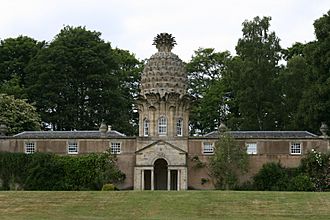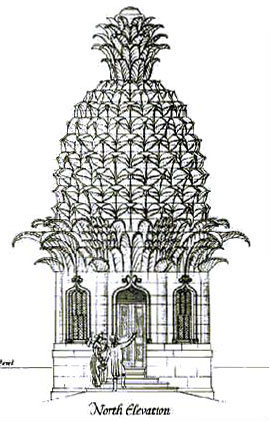Dunmore Pineapple facts for kids
Quick facts for kids The Dunmore Pineapple |
|
|---|---|
 |
|
| General information | |
| Location | Scotland |
| Coordinates | 56°04′36″N 3°47′12″W / 56.07671°N 3.7867°W |
The Dunmore Pineapple is a super unique building in Scotland, often called the "most bizarre" one! It's a type of fun, decorative building known as a folly. You can find it in Dunmore Park, close to Airth in Stirlingshire.
Contents
Discovering Dunmore Park's Walled Garden
Dunmore Park was once the home of the Earls of Dunmore. It has a big house called Dunmore House and beautiful grounds. These grounds include two large walled gardens.
Why Walled Gardens Were Important
In the 1700s and 1800s, walled gardens were very important for big houses in cooler places like Scotland. The tall stone or brick walls protected the plants from wind and frost. This created a special warm area, called a microclimate, inside the garden. It allowed gardeners to grow fruits, vegetables, and pretty flowers that normally wouldn't survive so far north.
The biggest garden at Dunmore Park is about six acres. It's on a gentle slope facing south, which is perfect for growing plants that don't like frost. A strong retaining wall, about 16 feet (5 meters) high and 3 feet 3 inches (1 meter) thick, runs along the north side of the garden.
Sometimes, walled gardens had special hollow walls with furnaces inside. These furnaces would send heat into the garden through openings. This extra warmth was great for fruit trees or grape vines, helping them grow even in colder climates.
The Amazing Pineapple Building
In 1761, John Murray, 4th Earl of Dunmore, built a special building into this wall. This building had a hothouse on its ground floor.
Growing Pineapples in Scotland
The hothouse was used to grow exotic plants, including pineapples! The south-facing ground floor, which is now covered in stucco and vines, used to have many glass windows. A heating system with a furnace kept the hothouse warm. Hot air moved through special spaces in the walls. The smoke from the furnace went out through four chimneys that looked like fancy Greek urns.
The upper floor of the building was at ground level if you approached it from the north lawn. This floor had two small apartments, called "bothies," where the gardeners lived.
A Mix of Styles
Lord Dunmore left Scotland after the first part of the building was finished. He became the last Colonial Governor of Virginia in America. The pineapple-shaped top part, called a cupola, and the fancy lower entrance (called a Palladian portico) were added after he came back from Virginia.
The Dunmore Pineapple is a mix of different building styles. The main entrance on the south side has a classic Palladian archway with Tuscan columns. If you walk through this arch, you'll see a detailed doorway with painted Ionic columns. The date "1761" is carved into the arch. Some people think this means the pineapple was built then, but others believe it was added later, after Lord Dunmore returned in 1776.
Above the arch, there's a stone panel with a heart and a special symbol. It also has the motto Fidelis in Adversis, which means "Faithful in Adversity." This likely celebrates the marriage of George Murray, 5th Earl of Dunmore, to Lady Susan Douglas-Hamilton in 1803.
The Famous Pineapple Top
The amazing stone pineapple sits between the two gardener's apartments. It's a detailed cupola on top of an eight-sided room. This room has sash windows with Gothic arches on seven sides. On the eighth side, there's a door that leads out to the upper garden level.
Inside, the walls of the room are gently curved, making it feel circular. Even the windows and door are curved to match the walls! The room is just big enough for a round table and some chairs.
The pineapple itself is about 14 meters (46 feet) tall. It's an incredible example of a stonemason's skill. Each stone "leaf" is designed to drain water away, preventing frost damage. This careful design protects the delicate stone work.
Even though the building mixes different styles, it looks very balanced. The pineapple and the lower entrance are made of the same stone, giving it a consistent look. The height of the building is exactly half its width, and the width of the entrance matches the height of the south side. These details, along with the four urn-shaped chimneys, make the building feel very orderly and harmonious.
No one is completely sure who designed this unique building. Some people think it was Sir William Chambers. He designed similar playful buildings at Kew Gardens and was known for his attention to detail, like curved glass and chimneys disguised as urns.
Pineapples as a Cool Design
Did you know that pineapples were first brought to Europe by Christopher Columbus in 1493? They quickly became a rare and expensive treat. Because they were so special, pineapples became a symbol of power, wealth, and being a good host.
That's why you can see pineapple designs everywhere in old buildings! Architects, artisans, and craftsmen used the pineapple shape in gateposts, railings, weather vanes, and above doors. You could also find pineapple designs in interior decoration, on fabrics, and on furniture.
Who Owns It Now?
For many centuries, the Dunmore Estate belonged to the same family. But in 1970, it was divided up and sold. The "Pineapple Lot," which included the pineapple building, the walled garden, some woods, and a small lake, was bought by the Countess of Perth.
In 1974, she gave it to the National Trust for Scotland. The "Pineapple Lot" was then leased to the Landmark Trust. They carefully fixed up the building and now use it as a holiday rental!
The 6.5 hectares (16 acres) of gardens, including woodlands, a pond, and a crab-apple orchard, are open to the public all year round.
As of 2014, you can rent the gardeners' apartments and the pineapple summerhouse for a holiday. One side of the building has two bedrooms and a bathroom. The other side has a kitchen and a spacious living room. The rooms have sash windows that face south, letting in lots of sunshine throughout the day.
A Lasting Legacy
The Dunmore Pineapple is often seen as one of the most amazing "follies" in the United Kingdom. It's been featured on lists of best follies by famous groups like Huffington Post, the TV show Countryfile, and gardener Alan Titchmarsh. It truly is a memorable and unique building!



